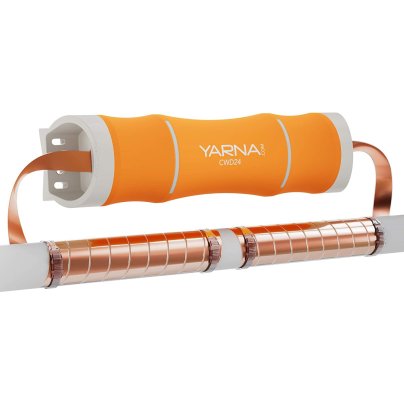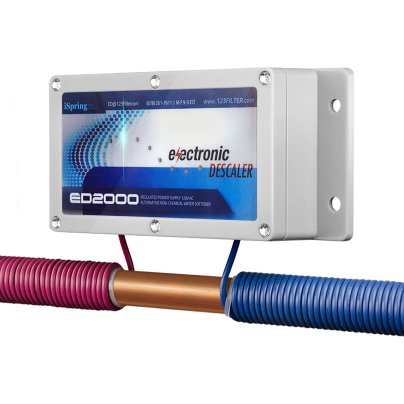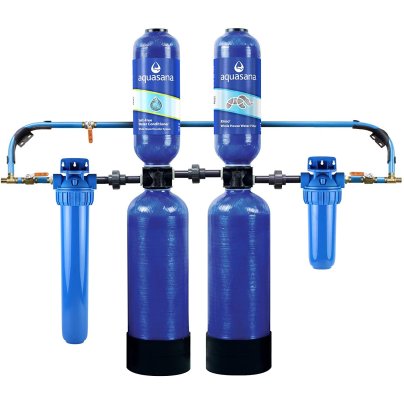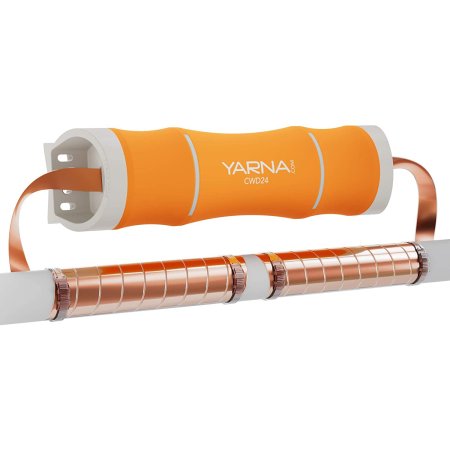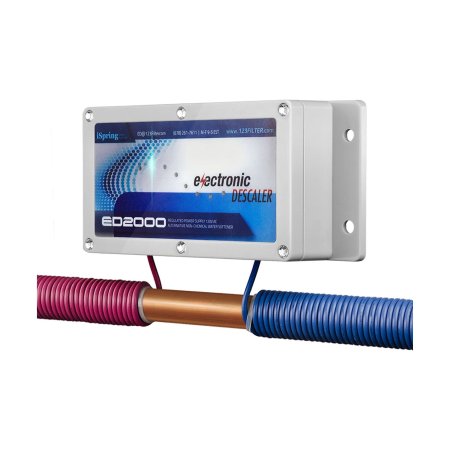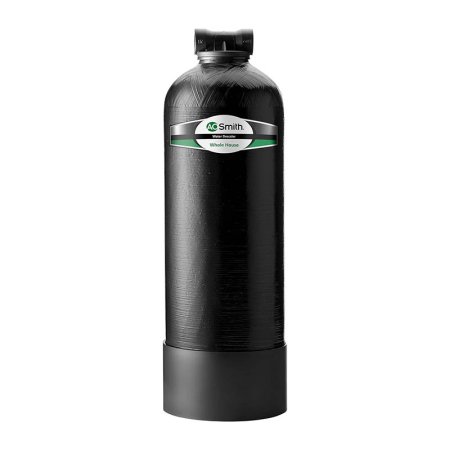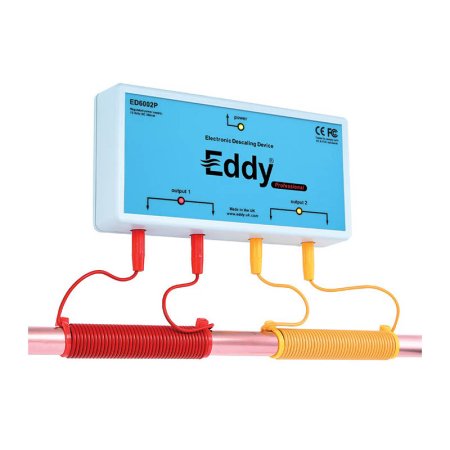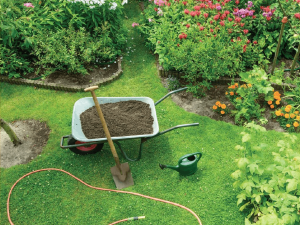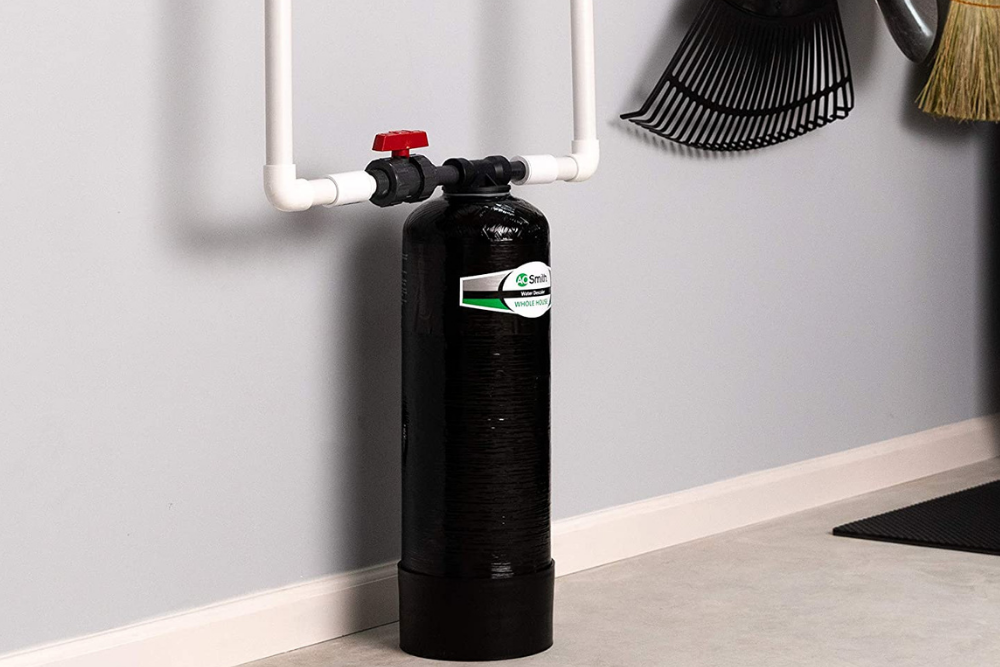
We may earn revenue from the products available on this page and participate in affiliate programs. Learn More ›
Salt-free water softeners may not be as common a solution to hard water problems as traditional models, but these systems are often easier to install, cheaper to maintain, and better for producing healthier water. Since many homeowners aren’t familiar with them yet struggle with scaling and clogged water lines, we researched a range of popular salt-free systems and reached out to a plumbing expert to compile a list of five top options.
Based on our product research and expert’s insights, we chose the Yarna Capacitive Electronic Water Descaler System as our best overall pick for its compact construction, unlimited flow rate, and easy 15-minute installation. Read on to learn more about the models that made our list and see why these systems are such a smart option. By understanding how they work and which of the best salt-free water softeners we recommend, you can choose the right unit for your home.
- BEST OVERALL: Yarna CWD24 Capacitive Electronic Water Descaler
↓ Jump to Review - BEST BANG FOR THE BUCK: iSpring ED2000 Whole-House Water Descaler
↓ Jump to Review - UPGRADE PICK: Aquasana Rhino Whole-House Salt-Free Water Filter
↓ Jump to Review - BEST WHOLE-HOUSE: AO Smith Whole-House Salt-Free Descaler
↓ Jump to Review - BEST ELECTRIC: Eddy Electronic No-Salt Whole-House Water Softener
↓ Jump to Review

Before You Buy a Salt-Free Water Softener
According to Roy Barnes, master plumber and co-owner of Rockville, Maryland’s Service Force Plumbing, the term “softener” is a bit of a misnomer. “Water softeners actually eliminate the causes of hard water, mostly calcium and magnesium, and make it ‘un-hard’ (i.e., soft). Salt-free systems don’t actually remove [these minerals] but seek to mitigate their effects.”
Salt-based water softeners require the regular addition of salt in combination to draw out minerals, preventing them from causing scaling on plumbing while also making soap sudsier for bathing, washing dishes, and cleaning clothes.
As their name suggests, salt-free systems don’t use salt. Rather, they soften hard minerals so they don’t build up on faucets and showerheads. While salt-free water softeners are an excellent option for many homeowners, they may not be adequate for those with very hard water or serious issues like lead contamination. To help decide whether a salt-free water softener is right for you, consider your home’s water quality by looking for signs your home needs a water softener and performing a hard water test.
Best Salt-Free Water Softeners Comparison Chart
| Product Name | Type | Size | Flow Rate |
| Yarna CWD24 Capacitive Electronic Water Descaler | Electromagnetic | 6 inches long and 2 inches in diameter | Unchanged, attaches to max 1-inch diameter pipes |
| iSpring ED2000 Whole-House Water Descaler | Electromagnetic | 3.5 inches high by 7 inches wide by 2 inches deep | Unchanged |
| Aquasana Rhino Whole-House Salt-Free Water Filter | Whole-house filtration system | 54 inches high by 46 inches wide by 9 inches deep | 7 gallons per minute |
| AO Smith Whole-House Salt-Free Descaler | Whole-house filtration system | 26.5 inches tall by 8 inches in diameter | 7 gallons per minute |
| Eddy Electronic No-Salt Whole-House Water Softener | Electromagnetic | 3.5 inches high by 6.75 inches wide by 1.5 inches deep | Unchanged |
Our Top Picks
We narrowed down a range of popular products to this list of five top picks, each with its own pros and cons. Each of these salt-free water conditioners are effective and easy to install.
Best Overall
Yarna CWD24 Capacitive Electronic Water Descaler
What We Like
- Compact and efficient
- Installs in about 15 minutes
- Little to no maintenance is required
What We Don’t Like
- Treated water will revert back in 2 to 7 days
- 10 inches of pipe space required for installation
Specs
- Type: Electromagnetic
- Size: 6 inches long by 2 inches in diameter
- Flow rate: Unchanged, attaches to max 1-inch diameter pipes
The Yarna Capacitive electronic water descaler earned the best salt-free water softener system award for its effective design and easy installation process—no plumbing skills required. The innovative descaler uses copper bands wrapped around a section of your home’s main water lines. As water flows through that section, the system emits electrical impulses that convert hard particles into small crystals. These crystals don’t stick to one another, preventing scale buildup in pipes and appliances.
This simple hard water treatment system only takes 15 minutes to install, and no tools are necessary. Simply locate about 10 inches of pipe on your main water line (up to 1 inch in diameter) and a nearby outlet. Wrap the copper bands around the pipe, plug the unit in, and enjoy maintenance-free water softening.
Get the Yarna salt-free water softener at Amazon or Yarna.
Best Bang for the Buck
iSpring ED2000 Whole-House Water Descaler
What We Like
- Electromagnetic design reduces energy consumption
- Works on a hardness of 10 to 19 grains per gallon
- Easy DIY installation
What We Don’t Like
- Water reverts back after traveling 50 feet
Specs
- Type: Electromagnetic
- Size: 3.5 inches high by 7 inches wide by 2 inches deep
- Flow rate: Unchanged
With a simple, maintenance-free design, this affordable descaler is an attractive option for eliminating harmful scaling without a lot of effort. It works by applying electromagnetic impulses to water as it passes through a supply pipe, stopping it from forming deposits that can clog pipes, damage appliances, and affect skin and hair.
As with our top pick, installation requires no plumbing knowledge. Wrap the unit’s wires around a section of water line entering the home (to create a coil that serves as a conduit for the electromagnetic impulses), and plug it into a standard 115-volt outlet. This water softener for home use is suitable for water hardness levels between 10 and 19 grains per gallon, but water will revert back to its original state after moving through about 50 feet of pipe. Large homes may need to add another unit farther down the plumbing line to remedy this issue.
Get the iSpring salt-free water softener at Amazon, Lowe’s, or The Home Depot.
Upgrade Pick
Aquasana Rhino Whole-House Salt-Free Water Filter
What We Like
- Improves both water quality and hardness
- Removes contaminants and minerals from water
- Filters last over 3 months
What We Don’t Like
- More expensive since it’s also a filtration system
- Professional installation is recommended
Specs
- Type: Whole-house filtration system
- Size: 54 inches high by 46 inches wide by 9 inches deep
- Flow rate: 7 gallons per minute
While this water softener is more of an investment than other options on this list, that’s because it doesn’t simply mitigate hardness—it also removes impurities to enhance purity and taste. The Rhino uses carbon and KDF filters to eliminate calcium, lime, iron, and other minerals as well as contaminants like mercury, chlorine, lead, herbicides, and pesticides. If you are looking for a water softener for well water, this is an excellent choice.
With a flow rate of 7 to 8 gallons per minute, this water filtration system is best in households with four or fewer members. It uses two main filters that should each last about 3 months before requiring replacement. Since installation requires plumbing the system into your home’s main water line, you may want to seek the help of a professional if you don’t have much plumbing knowledge.
Get the Aquasana salt-free water softener at Amazon, Walmart, or Aquasana.
Best Whole-House
AO Smith Whole-House Salt-Free Descaler
What We Like
- Lasts over 600,000 gallons or up to 6 years
- Lower home water filtration system cost than that of many units
- Easy to add a sediment filter, central water filter, post-filter, and ultraviolet (UV) filter
What We Don’t Like
- Requires plumbing into main water line
Specs
- Type: Whole-house filtration system
- Size: 26.5 inches tall by 8 inches in diameter
- Flow rate: 7 gallons per minute
Replacing water filters every few months can be a pain, but this whole-house water softener offers a hassle-free solution. It installs directly into the main water supply line, requires no electricity or frequent filter changes, and effectively descales water to prevent buildup on faucets, sinks, showers, and appliances.
With a 600,000-gallon lifespan—roughly 6 years for a family of four—this descaler provides long-lasting, low-maintenance operation. You can use it on its own or pair it with AO Smith’s whole-home system, which includes a sediment filter, central water filter, post-filter, and UV filter for comprehensive water treatment.
Get the AO Smith salt-free water softener at Amazon or Lowe’s.
Best Electric
Eddy Electronic No-Salt Whole-House Water Softener
What We Like
- Consistently prevents scaling
- Easy installation and maintenance
- Longer cables available for pipers larger than 1 inch
What We Don’t Like
- Requires access to an outlet
Specs
- Type: Electromagnetic
- Size: 3.5 inches high by 6.75 inches wide by 1.5 inches deep
- Flow rate: 10 gallons per minute
With a low-maintenance yet effective design, the electronic water descaler from Eddy is a good solution for those dealing with deposits clogging faucets, pipes, and appliances. This descaler consists of two wires that wrap around the main supply line entering the home to create an electromagnetic field that prevents minerals from sticking to one another or surfaces and causing scaling.
Unlike other water-softener types, this descaler won’t affect the flow rate of water into your home. It can treat up to 10 gallons of water per minute, is easy to install with no plumbing required, and plugs into a standard 115-volt outlet.
Get the Eddy salt-free water softener at Amazon or Walmart.
Jump to Our Top Picks
How We Chose the Best Salt-Free Water Softeners
When gathering our top picks for water softeners, we included both salt-free water conditioners that are simple electromagnetic units as well as whole-house filtering systems that provide additional benefits. Electromagnetic units are typically small water softener systems that are relatively inexpensive, simple to install, and require little to no maintenance. Rather than removing minerals, they simply alter them to prevent them from causing scale buildup.
Whole-house filtration systems filter out common water contaminants in addition to softening water, providing a more comprehensive water treatment solution. While these larger salt-free water conditioners may require professional installation, they are worth the investment for those dealing with problems caused by hard water or looking for well water softener systems.
What to Consider When Choosing a Salt-Free Water Softener
Understanding how the best salt-free water softeners work and how much water they can treat each day is integral to purchasing the right soft water system for a home.
Type
There are several types of salt-free water softeners on the market, each with its pros and cons. These types include polyphosphates, electromagnetic and magnetic, and full filtration.
Polyphosphates
The use of phosphates to soften water is a practice that dates back nearly 200 years. Instead of removing impurities from the water, this process conditions the water so impurities cannot create scaling on plumbing or faucets using a filtration cartridge. This type of system is used primarily in restaurants and other commercial settings to protect appliances from scaling.
Electromagnetic and Magnet
Like all salt-free water softeners, electromagnetic softeners don’t remove hard water particles but instead condition them to prevent scaling. These softeners work by magnetizing mineral grains so they don’t adhere to surfaces, a process that doesn’t require plumbing but does require power from an electrical outlet.
Magnetic models perform the same task but without the use of electricity. However, they are not as powerful as electromagnetic models and are only suitable for very small homes.
Full Filtration
Whole-house water filter and softener systems soften water and remove other contaminants. They typically require installation into your home’s main plumbing line and work by crystallizing minerals so they don’t stick together and cause scaling. Since they also remove contaminants like herbicides, bacteria, viruses, pesticides, and chlorine, they are generally more expensive than basic salt-free systems. Their filters also require regular replacement.
Size and Water Usage
The best salt-free water softeners come in different sizes to meet each household’s water usage and hardness needs. Needing to treat harder water can increase a water softener system’s cost.
To calculate water usage, multiply the number of people living in your home by the average use rate of 75 gallons per day. Using this equation, a family of three will use an average of 225 gallons of water per day.
To determine water hardness, which is measured in grains per gallon, you’ll need a water test kit. Water with 7 to 10.5 grains per gallon is moderately hard, while water with more than 10.5 grains per gallon is very hard.
To calculate which size softener you need, multiply water hardness by water usage. A home that uses 225 gallons of water per day with a water hardness of 10 grains per gallon requires a water softener with a capacity of 2,250 grains per day.
Flow Rate
A salt-free water-conditioning system sits between the main water line’s intake and outtakes, treating water as it flows into your home’s plumbing. Since electromagnetic water treatment systems aren’t plumbed into your home’s water system, they don’t affect flow rate.
However, salt-free systems that use filtration can affect water flow, potentially slowing it. Therefore, water softeners with filtration systems must have a flow rate that meets the demands of the household to prevent a drop in water pressure. Homes with one to three bathrooms need a filtration system with a flow rate between 8 and 12 gallons per minute. Larger households require around 15 gallons per minute.
Installation
Installing a water softener that’s salt free is generally relatively easy. While traditional salt softeners typically require professional installation, salt-free systems don’t require any plumbing knowledge and will likely only take about 15 minutes for the average DIYer to install. All you need to do is wrap the unit’s wires around your water supply pipe and plug it in.
Full filtration systems and whole-house systems are more involved. Unlike under-sink water filters, descaler and filtration combination systems generally need to be plumbed into the incoming water supply pipe. Still, these units are typically designed to be relatively quick and easy to install, meaning some DIYers may be up to the task.
The Advantages of Using a Salt-Free Water Softener
The benefits of a soft water system that’s salt free range from producing healthier water to being easier to maintain, install, and operate.
- They’re healthier: Unlike traditional water softeners, salt-free water softeners do not use sodium chloride, meaning they don’t add salt to drinking water. This can be a significant benefit if members of the household must limit their salt intake due to high blood pressure or other health issues.
- They’re low maintenance: Unlike traditional water softeners, which must be refilled with 40 pounds or more of salt each month and periodically cleaned, salt-free water softeners require very little maintenance. While some units have water filters that must be replaced every 3 to 6 months, electromagnetic models require little to no maintenance whatsoever.
- They have low operating costs: Since traditional water softeners require a steady stream of water softener salt and electricity to create the ionization process that softens water, they have higher operating costs. Salt-free systems do not salt, meaning they are less expensive to operate over time.
- They protect plumbing and appliances: As with salt-based water softeners, salt-free water softeners eliminate scaling that can clog pipes. This helps optimize the performance of washing machines, hot water heaters, and dishwashers.
FAQs
Though you likely aren’t still asking yourself, “What is a water softener?” you may still have questions about how salt-free water softeners work or if your new water softener is functioning properly. Below are answers to some of the most commonly asked questions about these appliances.
Water softeners work by treating the water as it enters the home. Salt softeners eliminate minerals that cause hard water, whereas salt-free systems reshape minerals from water so they can’t accumulate and create scaling.
Salt-free water softeners are not designed to remove anything from water, including iron. If you need to remove iron, it’s best to go with a traditional water softener or a full-filtration salt-free system.
A water softener should prevent deposits from building up on faucets, sinks, and toilets. You should also notice it takes less soap and shampoo to create suds. For a more quantifiable indicator, measure water hardness with a water test kit before vs. after installation.
Most salt-free water softeners require no cleaning, though it’s a good idea to periodically wipe dust and dirt from the coils. If you have a full-filtration unit, you will also need to periodically replace your machine’s filters as recommended by the manufacturer.
This depends on the type of salt-free water softener. An electromagnetic water softener can last up to 40 years or more, while an enclosed filter-based water softener may last up to 6 years before needing replacement.
The main downsides of traditional water softeners are that they remove healthy minerals, increase sodium content in water, and have ongoing operational costs. Salt-free systems retain mineral content and have lower ongoing associated costs, but they may not be powerful enough for large homes.
Yes, soft water is suitable for drinking, especially if it’s produced using a salt-free system. Salt-based softeners remove healthy minerals and add sodium, so it may be a less healthy option for some.
As relatively easy to install, low maintenance, and effective systems, salt-free water systems are worth it for many households. If you need to remove contaminants from your water, selecting a full-filtration system over an electromagnetic one is smart. If you have a larger home, you may need a traditional water softener to meet your needs.
Typical water softener system cost is about $1,500. The salt-free water softeners on our list cost between $100 and $1,750, averaging about $450.
